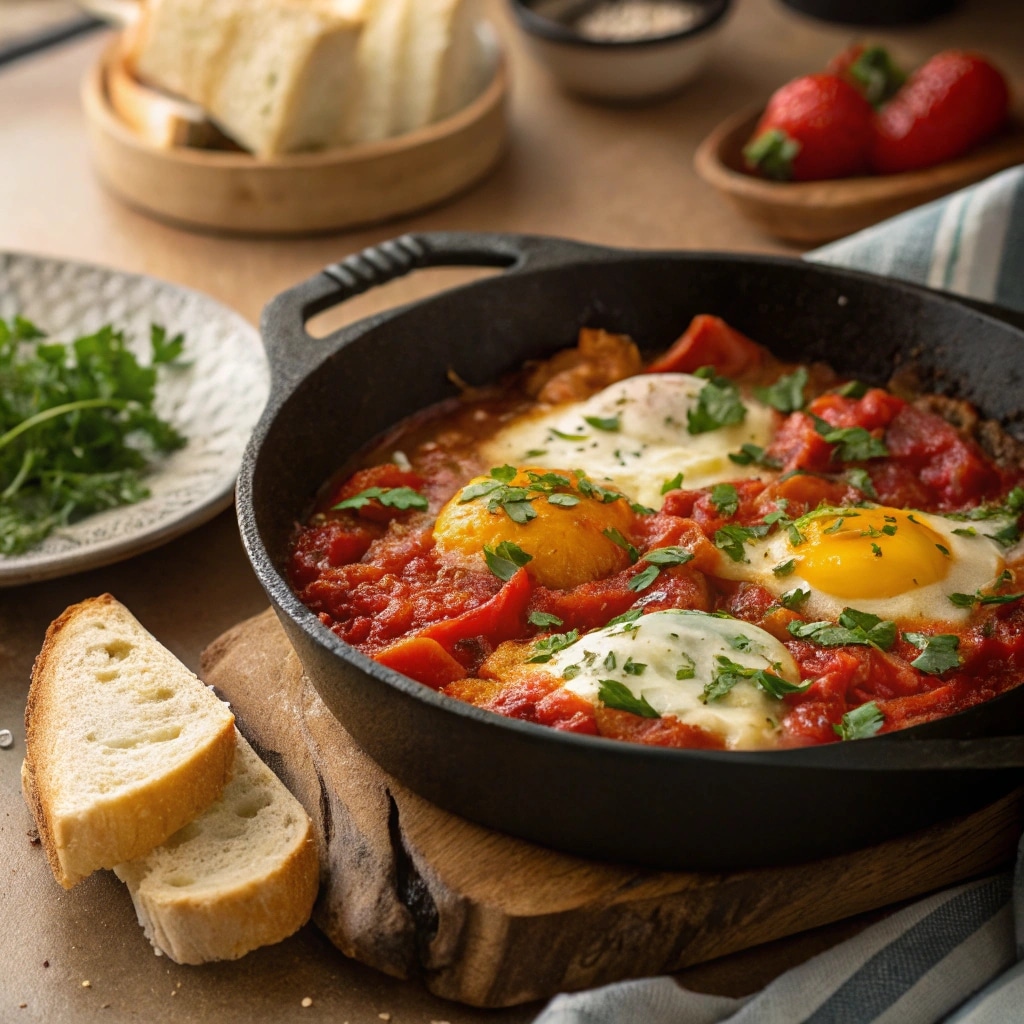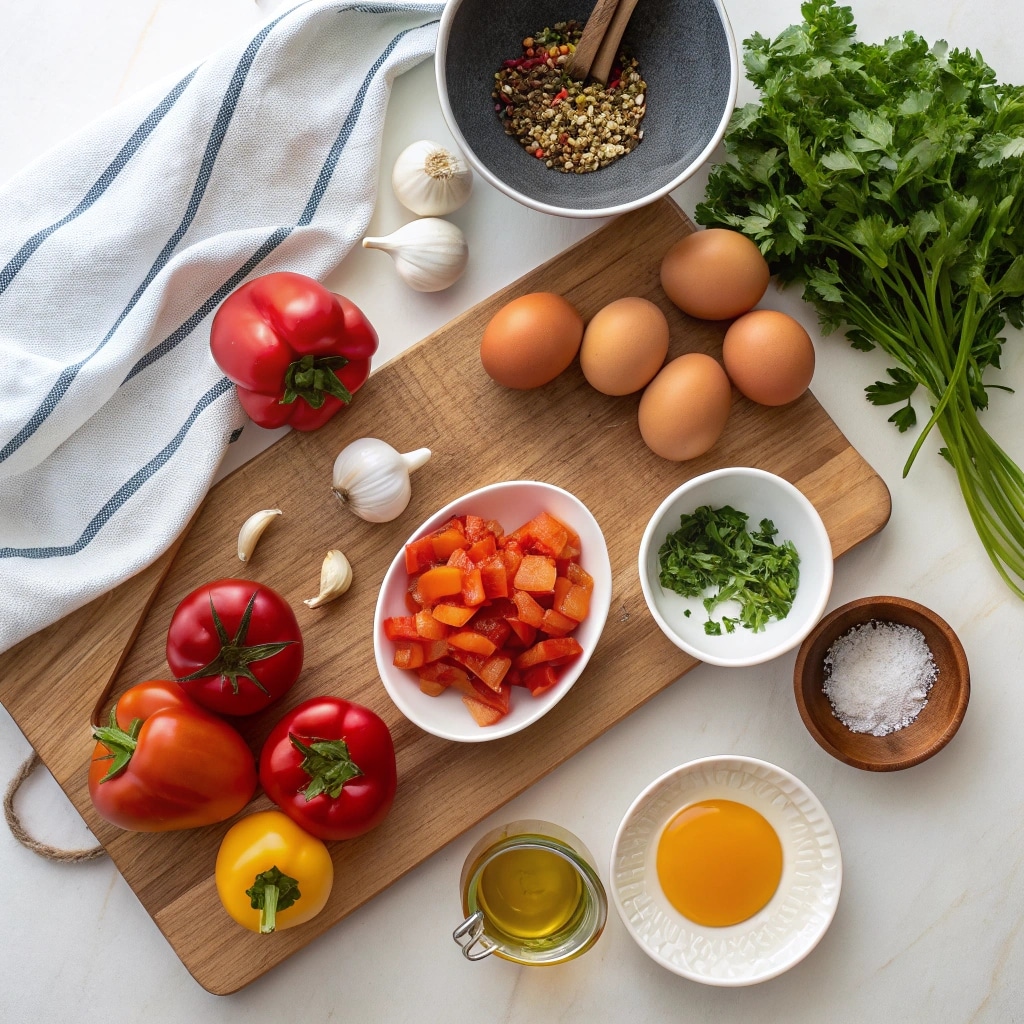Shakshouka stands out as more than just a dish it’s a tapestry of flavors, history, and cherished memories. In this article, you’ll discover my vibrant journey with shakshouka, including what truly goes into a classic version, its roots, the best ways to serve it, nutrition facts, and step-by-step practical tips that make it your next favorite meal. Along the way, you’ll find easy links to related Menumaison recipes and resources to enrich your breakfast or brunch experience.

Table of Contents
Introduction
Growing up, I often woke up to the enticing aroma of onions and tomatoes sizzling on the stovetop, a world away from instant breakfasts. My mother would toss in peppers and fragrant garlic before cracking eggs right into the bubbling sauce. That’s how I learned that shakshouka isn’t simply food it’s a memory in every bite. The comfort of scooping up rich tomato sauce and warm eggs with crusty bread created comfort and tradition in equal measure. In this guide, I’ll walk you through everything you need to enjoy shakshouka, including personalized tips, serving ideas, and nutrition insights, all inspired by the love for family meals that taught me to treasure simple ingredients.
Print
Authentic Shakshouka Guide: How to Make North African Breakfast
- Total Time: 30 min
- Yield: 4 servings 1x
- Diet: Vegetarian
Description
Classic shakshouka made with eggs poached in a richly seasoned tomato and pepper sauce. Simple, healthy, and full of comforting flavor.
Ingredients
2 tbsp olive oil
1 onion, diced
1 bell pepper, diced
4 cloves garlic, minced
2 tsp paprika
1 tsp cumin
1/4 tsp chili powder (optional)
1 can whole tomatoes (28 oz) or 6 ripe tomatoes
6 large eggs
Salt and pepper, to taste
Chopped fresh parsley or cilantro
Optional: crumbled feta
Instructions
1. Heat olive oil over medium heat, sauté onion and pepper until soft.
2. Add garlic, paprika, and cumin. Stir until fragrant, about 1 minute.
3. Pour in tomatoes, breaking them up. Add salt, pepper, chili powder. Simmer 10-15 min.
4. Make 6 wells in sauce. Crack an egg into each well.
5. Cover and cook 5–8 min, until whites are set, yolks runny.
6. Garnish with parsley or cilantro, add feta if desired. Serve immediately.
Notes
Simmer sauce longer for thicker consistency.
Use fresh tomatoes when in season.
Add extra herbs or spices to taste.
Serve with crusty bread or pita.
- Prep Time: 10 min
- Cook Time: 20 min
- Category: Breakfast, Brunch, Main
- Method: Stovetop
- Cuisine: North African, Mediterranean
Nutrition
- Serving Size: 1 plate
- Calories: 146
- Sugar: 5g
- Sodium: 256mg
- Fat: 9g
- Saturated Fat: 2g
- Unsaturated Fat: 7g
- Trans Fat: 0g
- Carbohydrates: 10g
- Fiber: 2g
- Protein: 7g
- Cholesterol: 164mg
The Heart of Shakshouka: Flavor, Story, and Family
A Personal Memory in a Skillet
Let me take you into my kitchen for a genuine shakshouka morning. I remember how my hands got stained from tomatoes while my grandmother showed me how to build flavor with little more than a sturdy pan and lots of attention. Shakshouka starts with olive oil, onions, bell peppers, and plenty of garlic, slowly cooked until soft. Tomatoes follow, broken down with the back of a spoon, then seasoned with cumin, paprika, and a gentle touch of chili. The kitchen fills with the warmth of home, and when the eggs drop in, they poach right in the sauce, their sunny faces peeking through the simmer.
As the fragrant sauce bubbles, stories come out tales of old markets, bustling family tables, and the thrill of scooping every last bit with fresh pita. Shakshouka has always been about feeding body and heart, making mornings feel special no matter what’s ahead.
Related Menumaison links add an extra touch of inspiration. Discover my favorite flatbreads that soak up every part of the sauce and check out my guide to Mediterranean salads, which balance the richness of eggs with crisp greens.
Tradition Meets Today
Classic shakshouka isn’t just about ingredients it’s about resourcefulness passed down through generations. It’s traditionally made with sweet peppers and tomatoes, seasoned by what’s in the pantry. The beauty is in its adaptability: you can add a hint of chili for brightness, swap in your favorite herbs, or crumble feta on top if you like. It serves as a vegetarian favorite, celebrates seasonal produce, and adapts to every table.
For busy mornings, check out my quick brunch ideas at Menumaison, or explore how to assemble an easy mezze platter. Pairing shakshouka with an array of dips like hummus or roasted eggplant brings the experience full circle, just like in countless family meals before.
True Ingredients: What’s Inside a Traditional Shakshouka
The Base: Tomatoes, Peppers, and Spices
A traditional shakshouka rests on a handful of humble components. Start with:
- Olive oil
- Diced onions
- Sweet bell peppers
- Garlic cloves
- Ripe tomatoes (fresh or canned)
- Paprika
- Ground cumin
- Chili powder or flakes (optional, for heat)
- Salt and black pepper
Warm olive oil in a large skillet, then sauté the onions until they begin to soften. Add the peppers and continue cooking until both are tender. Garlic goes in next, just until fragrant. Season with cumin and paprika, then stir in tomatoes, letting everything meld until thickened into a rich, spoonable sauce. Adjust the heat and seasoning to your taste.

Adding the Eggs and a Finishing Touch
Crack eggs one by one into gentle wells made in the cooked sauce. Cover and simmer until the egg whites are firm but the yolks are still soft and runny. Sprinkle with chopped parsley or cilantro for color. Top with crumbled feta for a savory note or enjoy it plain for the full, unabashed tomato flavor.
More detailed method and serving ideas appear in my complete brunch section at Menumaison, where I walk through poaching eggs to perfection.
Nutrition Table for Traditional Shakshouka
| Nutrient | Amount (per serving) |
|---|---|
| Calories | 146 kcal |
| Protein | 7g |
| Carbohydrates | 10g |
| Fat | 9g |
| Fiber | 2g |
Related tips are available in my healthy breakfast tips section and my eggs nutrition guide, both found at Menumaison.
Shakshouka’s Roots: History, Culture, and Global Journey
North African Origins and Traditions
Shakshouka is a classic of North African cuisine, especially common in Tunisia, Libya, and the broader Amazigh regions. The original recipe traces back centuries, signifying “all mixed up” in both Arabic and the Amazigh languages. Over time, it traveled east across the Mediterranean, carried by Jewish and Arab communities seeking hearty, affordable meals. Each country and even each family developed its own version.
The dish reflects the ingenuity of generations who transformed humble vegetables into something flavorful and nourishing. In its early days, families would gather whatever fresh produce was available and simmer it in a shared pot, creating meals that brought people together for both conversation and comfort. From bustling North African markets to cozy Middle Eastern kitchens, it became a symbol of hearty, satisfying food enjoyed by all.
Shakshouka in Palestine and Beyond
Through migration and cultural exchange, shakshouka has become a beloved dish across the Middle East, especially in Palestine. Today, cities like Ramallah and Nablus are home to lively cafés and breakfast spots offering their own takes enhanced with fresh herbs, sumac, or spiced lamb.
Shakshouka is, above all, versatile. Its strength lies in its core method: poaching eggs in a richly seasoned tomato sauce, then allowing each cook or region to bring their own flair. For more Mediterranean breakfast ideas and stories of global comfort foods, visit Menumaison and explore ways to bring new life to your morning table.
How to Serve Shakshouka: Sides, Additions, and Modern Ideas
Bread, Salads, and Complementary Sides
The ideal companion to shakshouka is really good bread. You might reach for pita, challah, or a crusty sourdough anything sturdy enough to scoop up thick, spiced tomato sauce and velvety eggs. Toasted or fresh, the bread soaks up flavor, unites the dish, and offers texture.
For a balanced plate, add a simple salad: chopped cucumbers, tomatoes, and fresh herbs with lemon and olive oil bring a fresh, cool note. On richer mornings, try hummus or baba ganoush on the side. For added protein, serve with falafel or even a handful of savory roasted potatoes.
My Menumaison salad collection and guide to Middle Eastern mezze provide more ideas on rounding out your meal.
Creative Twists and Presentation
You can build a vegetarian feast with shakshouka as its centerpiece or make quick additions. Try sautéed greens or grilled vegetables for color and substance. Crumbled feta, sliced avocado, or a swirl of Greek yogurt add new flavors and look beautiful at the table.
Create stylish brunch spreads with my Menumaison brunch guide or impress at your next gathering by combining shakshouka with a mezze board.
Healthy, Delicious, and Everyday Friendly
Nutrition Perks of Shakshouka
Shakshouka tastes hearty while providing balanced nutrition. With eggs supplying protein, tomatoes offering lycopene, and vegetables delivering fiber and vitamins, it’s naturally supportive of heart, eye, immune, and digestive health. Spices like cumin and paprika add antioxidants, while olive oil delivers good fats.
A generous single serving remains low in calories, typically 140-160 per cup, making it a lighter breakfast option when compared with standard American choices. You get lasting satisfaction and energy without feeling weighed down.
Explore my healthy breakfast swaps and comparison guides for practical nutrition tips at Menumaison.
Everyday Practicality
Shakshouka is also practical: it’s easy to prepare, comes together in under 30 minutes, and works for breakfast, lunch, or dinner. Most ingredients are pantry staples. You can double the sauce and refrigerate or freeze it, then just poach eggs or add other extras when ready.
Get my make-ahead tips and quick brunch prep suggestions in the time-saving meals section at Menumaison.
Conclusion
Shakshouka represents the coming together of family, tradition, and wholesome nourishment. With roots in North Africa, embraced by cooks worldwide, it’s a celebration of home cooking made joyful and practical. The experience of sharing this hearty skillet meal, with its bold spices and vibrant tomato sauce, will enrich your morning routine and create memories of togetherness. Put your own spin on it each time mix up the sides and make it uniquely yours, just like my family has done for generations.
